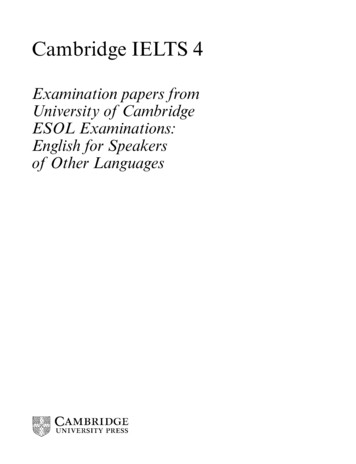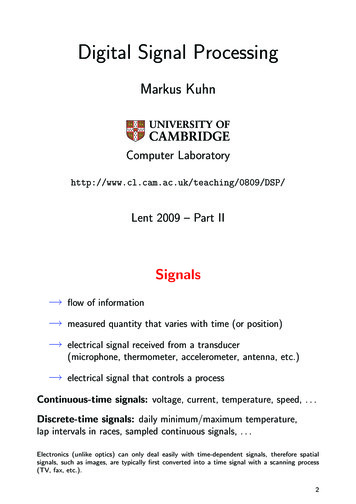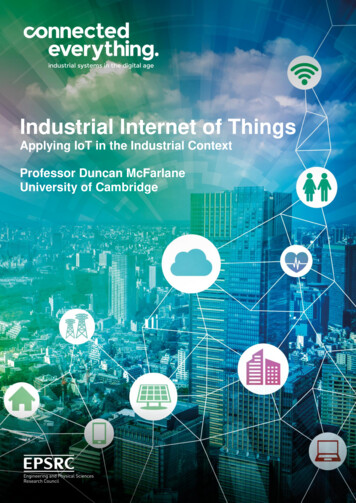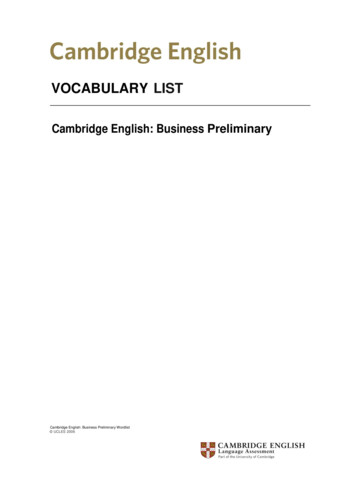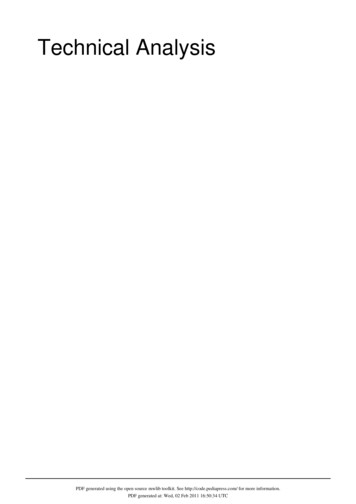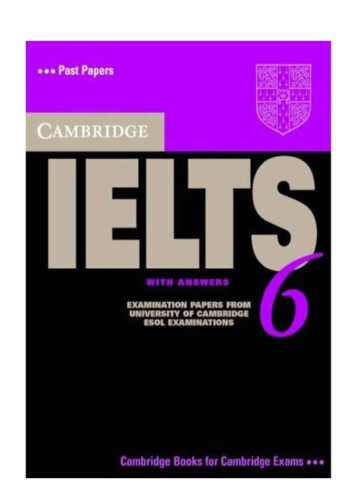
Transcription
Cambridge IELTS 6Examination papers fromUniversity of CambridgeESOL Examinations:English for Speakersof Other Languages CAMBRIDGE UNIVERSI TY P RESS
CAMBR I DGE UNIVERS ITY PRESSCambridge. New York. Melbourne, Madrid, Cape Town, Singapore, Sao PauloCambridge University PressThe Edinburgh Building, Cambridge CB2 8RU. UKwww.cambridge.orgInformation o n this title: www.cambridge.org/9780521693073 Cambridge University Press 2007It is normally necessary for written permission for copying to be obta ined inadvance from a publisher. The cand idate a nswer sheets at the back of thisbook a re designed to be copied and distributed in class. The no rmalrequirements are waived here and it is not necessary to write toCambridge University Press for permission for an individual teacher to makecopies tor usc within ltis or her own classroom. Only those pages which carrythe wording ' UCLES 2007 Photocop1.t ble ' may be copied.First published 2007] rinted in the United Kingdom at the University Press, CambridgeA catalogue record for this publication is m ailab/efrom the British LibmryISBNISBNISBNISBN978·0·521·693073 Sl1tdent's Book with answers978-0-521·693097 Cassette Set978-0-52 1-693103 Audio CD Set978-0-521-693080 Self-study f ack
ContentsIntroductionTest I10Test 233Test 355Test 4784General Training: Reading and Writing Test AI0 IGeneral Training: Reading a nd Writing Test B114Tapescripts127Answer key151Model a nd sample a nswers for Writing tasksSample answer sheetsAcknowledgements173176161
Test 1LISTE:\1!\GSECTIO N 1Questions 1- 10Questions 1-4Complete the notes below.Write NO MORE THAN THREE WORDS for each answe1:Notes on sports clubExampleAnswerName of club:JC.f!' \·!.':e! Facilities available:Golf1 . .2 . .Classes available: Kick-boxing 3 . .Additional facility:104. . . (restaurant openingsoon)
ListeningQuestio11s 5-8Complete rile table below.Wrire NO MORE THAN TWO NUMBERS (or each mswel:MEMBERSHIP SCHEMESTypeUse offacilitiesCost ofclassesTimesGOLDAllFreeAny timeSILVERAllBRONZERestricted6 . from 7 . to . 3f.-om 10.30 to 3.30weekdays onlyJ oiningfeeAnnualsubscriptionfee 2505 . 225 300 508 .Questio11s 9 alld 10Complete tile sentences below.Write ONE WORD ONLY for each cmsn·e1:9To join the centre, you need to book an instructor's . . . .10To book a tria l session, speak to David . (0458 95311 ).II
Test/SECTIO N 2Questions 11- 20Questions 11- 16What cha nge has been made to each part of the theatre?Choose S IX cmsll'ersfrom the box and ll'ri!e the correctletfel; A- G, nexf 10 ques!ions 11- 16.RIVENDEN CITY THEA TREA doubled in numberB given separate entrancecreduced in numberD increased in sizeE replacedF strengthenedG temporarily closedPart of the theatre11box office12shop13ordinary seats14seats for wheelchair users15lifts16 dressing roomst2
ListeningQuestio11s 17- 20Complete the table below.Write NO MORE THAN TWO WORDS AND/OR A NUMBER .for each lii1S1re1:PlayDatesRoyal HuntOctober 13th toof t!te Sun17 .Starting time18 . pmTickets availablePricefor 19 . .and .20 ··················13
Test ISECTION 3Questio11s 21- 30Questio11 21Choose the correct lelfe1; A, B or C21What is Brian going to do before the course starts?Aattend a classBwrite a reportCread a bookQuestio11s 22- 25Complete the table below.Write N O MORE THA N TWO WORDS for each ansll'el:College FacilityRefectoryInformationinform them 22 . . . . about special dietaryrequire ments23 .long waiting list, apply nowCareers advicedrop-in centre for informationFitness centrereduced 24 . for studentsLibraryincludes books, journals, eq uipmen t room containingaudio-visual materialsComputersask your 25 . to arrange a password withthe technical support team14
ListeningQuestio11s 26- 30Complete the summmy below.Write NO MORE THAN TWO WORDS.for each answer.Business CentreThe Business Resource Centre contains materials such as books and manuals tobe used for training. It is possible to hire 26 . and 27 . . .There are mat erials for working on study ski lls (e.g. 2S .) and othersubjects include flnance and 29 . .30 . membership costs 50 per year.15
Test ISECTION 4Questio11s 31- 40Questio11s 31- 37Complete the table be/ott:Write N O MOR E THAN T WO WORDS for each ans1re1:S ocial history of the East End of LondonP eriodSituationIst- 4th centuriesProduce from the area was used to 31. . . . thepeople of London.5th- 10th centuriesNew technology allowed the production of good s made of32 . and . . . .II th centuryLack of 33 . . . in the East End encouragedthe growth o f businesses.16th centuryConstruction of facilities for the building o f34 . stimulated international trade.Agricultural workers came from other parts o f35 . . . to look for work.17th centu ryMarshes were drained to provide land that could be36 . on.19th centuryInhabitants lived in conditions of great 37 . . .with very poor sanitation.16
ReadingQuestions 38-40Choose THREE leuers, A-GWhich THREE of the following problems are mentioned in connection with 20th centuryhousing in the East End?Aunsympathetic landlordsBunclean watercheating problemsDhigh rentsEovercrowdingFpoor standards of buildingGhouses catching fire17
Test/READII\GREADING PASS AGE 1You should spend about 20 minutes on Questions 1- 13, which are based on Reading Passage Ibelow.AUSTRALIA'SSPORTINGSUCCESSA They play hard. they play often, and they play to win. Australian sports teams win more thantheir fair share of titles, demolishing rivals with seeming ease. How do they do it?A big part ofthe secret is an extensive and expensive network of sporting academies under pinned byscience and medicine. At the Australian Institute of Sport (AIS), hundreds of youngsters andpros live and train under the eyes of coaches. Another body, the Australian Sports Commission(ASC), finances programmes of excellence in a total of 96 spor ts for thousands of sportsmenand women. Both provide intensive coaching. training facilities and nutritional advice.B Inside the academies, science takes centre stage. The AIS employs more than I 00 sportsscientists and doctors, and collaborates with scores oi others in universities and researchcentres. AIS scientists work across a number of sports. applying skills learned in one - such asbuilding muscle strength in golfers - to others. such as swimming and squash. They are backedup by technicians who design instruments to collect cata from athletes.They all focus on oneaim: winning. 'We can't waste our time looking at ethereal scientific questions that don't helpthe coach work with an athlete and improve performance; says Peter Fricker. chief ofscience at AIS.C A lot of their work comes down to measurement - everything from the exact angle of aswimmer's dive to the second-by-second power output of a cyclist. This data is used to wringimprovements out of athletes. The focus is on individLals, tweaking perfor mances to squeeze anextra hundredth of a second here, an extra millimetre there. No gain is too slight to botherwith. It's the tint. gradual improvements that add up to world-beating results.To demonstratehow the system works, Bruce Mason at AIS shows off the prototype of a 30 analysis tool ferstudying swimmers. A wire-frame model of a champion swimmer slices through the water, heranms moving in slow motion. Looking side-on, Mason measures the distance between strokes.From above, he analyses how her spine swivels. When fully developed, this system will enablehim to build a biomechanical profile for coaches to use to help budding swimmers. Mason'scontribution to sport also includes the development of the SWAN (SWimming AN alysis)system now used in Australian national competitions. It collects images from digital cameras18
Readingrunning at 50 frames a second and breaks down each part of a swimmer's performance intofactors that can be analysed individually - stroke length, stroke frequency. average duration ofeach stroke, velocity. start lap and finish times, and so on. At the end of each race, SWAN spitsout data on each swimmer.D 'Take a look,' says Mason, pulling out a sheet of data. He points out the data on the swimmers insecond and third place. which shows that the one who finished third actually swam faster. Sowhy did he finish 35 hundredths of a second down? 'His turn times were 44 hundredths of asecond behind the other guy,' says Mason.'If he can improve on his turns, he can do muchbetter.' This is the kind of accuracy that AI scientists' research is bringing to a range of sports.With the Cooperative Research Centre for Micro Technology in Melbourne, they aredeveloping unobtrusive sensors that will be embedded in an athlete's clothes or running shoesto monitor heart rate, sweating, heat production or any other factor that might have an impacton an athlete's ability to r un. There's more to it than simply measuring performance. Fricker givest he example of athletes who may be down with coughs and colds I I or 12 t imes a year: Afteryears of experimentation, AI and the University of Newcastle in New South Wales developeda test that measures how much of the immune-system prot ein immunoglobulin A is present inathletes' saliva. If lgA levels suddenly fall below a cer tain level, training is eased or droppedaltogether. Soon, lgA levels start r ising again, and the danger passes. Since the tests wereintroduced,A I athletes in all sports have been remarkably successful at staying healthy.EUsing data is a complex business. Well before a champ·ionship, sports scientists and coachesstart to prepare the athlete by developing a 'competition model', based on what they expectwill be the winning times. 'You design the model to make that time.' says Mason. 'A start of thismuch, each free-swimming period has to be this fast. with a certain stroke frequency and strokelength, with turns done in these times.' All the training is then geared towards making the athletehit those targets, both overall and for each segment of the race.Techniques like these havetransformed Australia into arguably the world's most successful sporting nation.F Of course. there's nothing to stop other countries copying - and many have tried. Some yearsago, the A IS unveiled coolant-lined jackets for endurance athletes.At the Atlanta OlympicGames in 1996, these sliced as much as two per cent off cyclists' and rowers' times. Noweveryone uses themT he same has happened to the 'attitude tent', developed by A I to replicatethe effect of altitude training at sea level. But Australia's success story is about more than easilycopied technological fixes, and up to now no nation has replicated its all-encompassing system.l9
Test 1Questions 1-7Reading Passage I has six paragraphs, A- F.Which paragraph contains the following information?Write the correct letter. A-F. in boxes 1- 7 on your answer sheet.You may use any letter m ore than once.NB1a reference to the exchange of expertise between different sports2an explanation of how visual imaging is employed in investigations3a reason for narrowing the scope of research activity4how some AIS ideas have been reproduced5how obs tacles to optimum achievement can be investigated6an overview of the funded support of athletes7how perfonnance requirements are calculated before an eventQuestions 8-11Classify the following techniques according to whether the writer states theyAare currently exclusively used by AustraliansBwill be used in the future by Australians.Care currently used by both Australians and their rivalsWrite the correct letter. A. B or C, in boxes 8-11 on your answer sheet.8cameras9sensors10protein tests11altitude tents20
ReadingQuestions 12 t nd 13Answer the questions below.Choose NO MORE THAN THREE WORDS AND/OR A NUMBER/rom the passage foreach answer.Write your answers in boxes 12 and 13 on your answer sheet.12What is produced to help an athlete plan their performance in an event?13By how much did some cyclists' performance improve at the 1996 Olympic Games?21
Test IREA DING PASSAGE 2You slrould spend about 20 minutes 011 Questions 14-26. wlriclr are hosed 011 R.eadi11g Passage 2beiOIV. f5DaOW@ 0(KJ@)?GO@ @@ Tlrt vast expansion in international trade owes much to a revolution in the businessof moving freightA International trade is growing at a startling pace. White the global economy has been expandingat a bit over 3% a year, the volume of trade has been rising at a compound annual rate of abouttwice that. Foreign products. from meat to machinery. play a more important rote in almost everyeconomy in the world, and foreign markets now tempt businesses that never much worriedabout sales beyond their nation's borders.8 What ties behind this explosion in international commerce? The general worldwide decline intrade barriers. such as customs duties and import quotas. is surely one explanation. Theeconomic opening of countries that have trad1t1onally been minor players is another. But oneforce behind the import-export boom has passed all but unnoticed: the rapidly falling cost ofgetting goods to market. Theoretically. in the world of trade. shipp1ng costs do not matter.Goods, once they have been made. are assumed to move instantly and at no cost fromplace to place. The real world, however. is full of frictions. Cheap labour may make Chineseclothing competitive in America, but if delays In shipment tie up working capital and causewinter coats to a
Cambridge IELTS 6 Examination papers from University of Cambridge ESOL Examinations: English for Speakers of Other Languages CAMBRIDGE UNIVERSITY PRESS . CAMBRIDGE UNIVERSITY PRESS Cambridge. New York. Melbourne, Madrid, Cape Town, Singapore, Sao Paulo Cambridge University Press The Edinburgh Building, Cambridge CB2 8RU. UK www.cambridge.org Information on this title: www.cambridge
